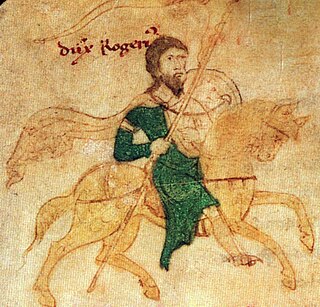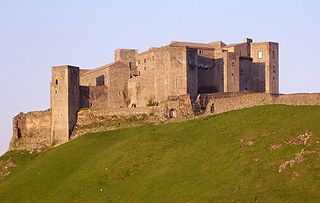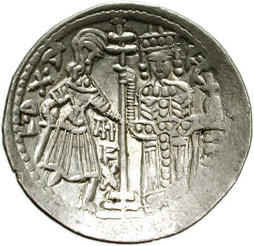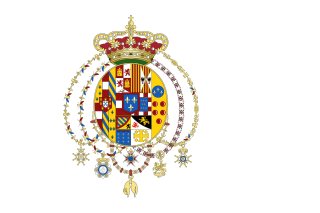
Frederick II was King of Sicily from 1198, King of Germany from 1212, King of Italy and Holy Roman Emperor from 1220 and King of Jerusalem from 1225. He was the son of emperor Henry VI of the Hohenstaufen dynasty and Queen Constance of Sicily of the Hauteville dynasty.

Roger II or Roger the Great was King of Sicily and Africa, son of Roger I of Sicily and successor to his brother Simon. He began his rule as Count of Sicily in 1105, became Duke of Apulia and Calabria in 1127, then King of Sicily in 1130 and King of Africa in 1148.
Assize or Assizes, in Old French originally "meeting, conference", may refer to judicial institutions or legal measures taken by those.

The Kingdom of Sicily was a state that existed in Sicily and the south of the Italian Peninsula plus, for a time, in Northern Africa from its founding by Roger II of Sicily in 1130 until 1816. It was a successor state of the County of Sicily, which had been founded in 1071 during the Norman conquest of the southern peninsula. The island was divided into three regions: Val di Mazara, Val Demone and Val di Noto.

The province of Avellino is a province in the Campania region of Italy. Its capital is the city of Avellino. The area is characterized by numerous small towns and villages scattered across the province; only two towns have a population over 20,000.

Ariano Irpino, or simply Ariano, is a comune (municipality) in the province of Avellino, in the Italian region of Campania. With a territory of 186.74 square kilometres (72.10 sq mi) and a population of 22,535 (2017), it is one of the largest settlements in the Irpinia historical district and the modern province. Located 264 kilometres (164 mi) east-southeast of Rome and 104 kilometres (65 mi) east-northeast of Naples, the comune was granted the official status of città ("city") by a presidential decree of 1952, October 26; it has been recognized as an arts town, too.

Robert II was the count of Aversa and the prince of Capua from 1127 until his death.

Alfonso, also called Anfuso or Anfusus (c. 1120 – 10 October 1144), was the Prince of Capua from 1135 and Duke of Naples from 1139. He was an Italian-born Norman of the noble Hauteville family. After 1130, when his father Roger became King of Sicily, he was the third in line to the throne; second in line after the death of an older brother in 1138. He was the first Hauteville prince of Capua after his father conquered the principality from the rival Norman Drengot family. He was also the first Norman duke of Naples after the duchy fell vacant on the death of the last Greek duke. He also expanded his family's power northwards, claiming lands also claimed by the Papacy, although he was technically a vassal of the Pope for his principality of Capua.
Ranulf II was the count of Alife and Caiazzo, and duke of Apulia. He was a member of the Italo-Norman Drengot family which dominated the Principality of Capua for most of the century between 1050 and 1150. Ranulf's wife, Matilda, was the sister of King Roger II of Sicily.

The Assizes of Ariano were a series of laws for the Kingdom of Sicily promulgated in the summer of 1140 at Ariano, near Benevento, by Roger II of Sicily. Having recently pacified the peninsula, constantly in revolt, he had decided to make a move to more centralised government. The assizes established the large Sicilian bureaucracy and sought to maintain the feudal system under strict royal control. It contained forty clauses that touched on all possible topics of contemporary legal concern: private property, public property, the church, civil law, royal finances, and the military. The work was advanced for its day, deriving its precepts not only from Norman and French, but also Muslim and Byzantine legal theories.

The Constitutions of Melfi, or Liber Augustalis, were a new legal code for the Kingdom of Sicily promulgated on 1 September 1231 by Emperor Frederick II. It was given at Melfi, the town from which Frederick's Norman ancestors had first set out to conquer the Mezzogiorno two centuries earlier. Originally a reform of the Assizes of Capua of 1220, themselves his reform of the Assizes of Ariano of 1140, the Constitutions formed the basis of Sicilian law for the next six centuries.

Roger III was the eldest son of King Roger II of Sicily and Elvira of Castile. He was the Duke of Apulia from 1134 until his death.

The House of Hauteville was a Norman family originally of seigneurial rank from the Cotentin. The Hautevilles rose to prominence through their part in the Norman conquest of southern Italy. By 1130, one of their members, Roger II, was made the first King of Sicily. His male-line descendants ruled Sicily until 1194. Some Italian Hautevilles took part in the First Crusade and the founding of the Principality of Antioch (1098).

The Norman conquest of southern Italy lasted from 999 to 1194, involving many battles and independent conquerors.

The Kingdom of the Two Sicilies was a kingdom in Southern Italy from 1816 to 1861 under the control of a cadet branch of the Spanish Bourbons. The kingdom was the largest sovereign state by population and land area in Italy before the Italian unification, comprising Sicily and most of the area of today's Mezzogiorno and covering all of the Italian Peninsula south of the Papal States.

The Sicilian Parliament was the legislature of the Kingdom of Sicily.
Graham Anthony Loud is a professor emeritus of medieval history at the University of Leeds. Loud is a specialist in the history of southern Italy during the Central Middle Ages, and also in German history in the Staufen period.
Swabian Sicily denotes the period in the history of Sicily during which it was ruled by the Hohenstaufen dynasty, lasting from Henry VI's's accession to the island's throne in 1194 until Manfred of Sicily's defeat by Charles I of Anjou in 1266. It has been particularly researched by German scholars such as Ernst Kantorowicz and Willy Cohn.
Henry of Morra was a nobleman, judicial official and sometime regent of the Kingdom of Sicily, which at the time covered both the island of Sicily and the mainland southern Italy. As master justiciar of the Magna Curia from 1223 until his death, he was the most prominent official in the Sicilian court of Frederick II, King of Sicily and Holy Roman Emperor.











